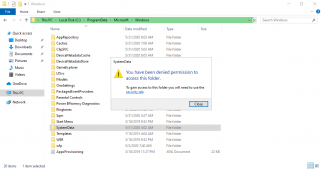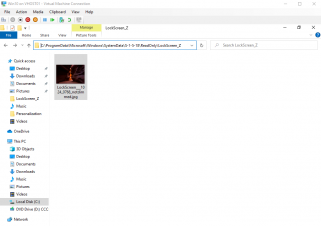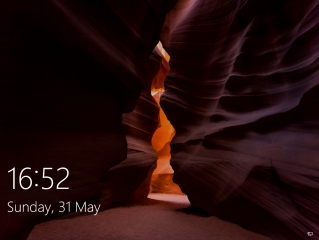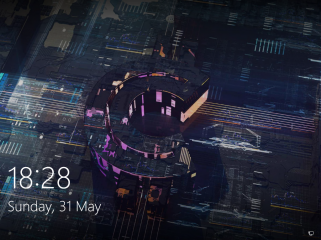Hello World,
In the previous post, we have quickly shown how to customize and personalize the Desktop Background on Windows 10 machine. When your windows 10 machine is not activated, Microsoft has limited the possibility to customize the look’n feel of Windows 10 through the Windows interface. You will need to use other techniques to perform the changes. While the process is made more complicated, it’s still possible to customize the Desktop Background.
This post will focus on the customization of the login screen. Again, when your Windows 10 machine is not activated, Microsoft is preventing you to customize the login screen through the applet or settings interface. However, it’s again still possible to overcome this limitation and customize your login screen.
This post will mainly explain how to perform the login screen customization on standalone machines (we are not using any GPOs in this post !!!) and whatever the Windows 10 Edition you are running (Home, Pro, Enterprise).
Let’s go !
Overview
Problem Description
When your Windows 10 is not (yet) activated, you will notice that the windows application that allows you to customize your system has some limitations. In the Settings Page > Personalization section, on the left menu, if you click on the Lock Screen option, you will see a notification message (in red) that you cannot customize your Windows 10 machine as long as it’s not activated
Click on Picture for Better Resolution
At this stage, we had to find another way to customize the login screen. So, let’s check how can do this…..
Possible Workarounds
Option 1 – Replacing the Default image used by the login screen (Obsolete method)
This method consist of replacing the default image used by the login screen by the image to be used in the login screen. This method is still working but requires to manipulate file permissions and find the correct file name. There is a better way to customize the login screen (which will be explained in point 2). However, to provide a complete set of options, we are still listing this method.
The login screen in use by Windows 10 is located at this location
%ProgramData%\Microsoft\Windows\SystemData\S-1-5-18\ReadOnly\
To customize the login screen, you will simply need to replace the image currently in used by the one you want to use. The problem is that when you try to access the %ProgramData%\Microsoft\Windows\SystemData\ folder, you get an access denied
Click on Picture for Better Resolution
You will need to take ownership of the folder in order to be able to browse and access the picture file to be replaced. We can use the Windows Explorer interface or you can use the following command line
TAKEOWN /F %ProgramData%\Microsoft\Windows\SystemData /R ICACLS %ProgramData%\Microsoft\Windows\SystemData /setowner Administrators /T /CI ICACLS %ProgramData%\Microsoft\Windows\SystemData /grant:r Administrators:F /T /CI
When you have access to the folder location, you can decide to delete and replace the image (use the same name) and logoff/logon and you should see that your login screen has been updated accordingly
Click on Picture for Better Resolution
You can check that the change has been applied successfully by login off and check your new custom login screen
Click on Picture for Better Resolution
This option is working but there is a better way to customize the login screen…. Keep reading
Option 2 – Using the Configuratin Service Provider (CSP) Method (Better Method)
Instead of messing around with the NTFS permissions, there is actually a better way to customize the login screen. Since Windows 10 1703, there is a new way to configure login screen on Windows 10. Actually, if you try to customize the login screen through the “classic” GPO, this will not work because the way windows 10 1703 process the information has changed (we will speak about this in a future post…)
In Windows 10, the new way of customization login screen is based on a new feature (new approach based on MDM implementation) called Configuration Service Provider (CSP) Personalization. The CSP Personalization process consists of adding/modifying some registry keys on the system. When these registry keys are created, it’s possible to specify a folder location where the picture to be used as background login can be found. This approach is much more cleaner and provide more flexibility.
We can create the registry key manually or you can use the following Powershell script that will help automate the process. Please note that you have to update it in order to reflect your own settings.
Note :
I didn’t write the script. I have used the PowerShell Script provided by the LazyAdministrator Web site ( the original script can be found here)
#--------------------------------------------------------------------------------
# Name : Set Login Screen using CSP Personalization feature
# Credits : https://www.thelazyadministrator.com
# ------------------------------------------------------------------------------------
$RegKeyPath = "HKLM:\SOFTWARE\Microsoft\Windows\CurrentVersion\PersonalizationCSP"
$LockScreenPath = "LockScreenImagePath"
$LockScreenStatus = "LockScreenImageStatus"
$LockScreenUrl = "LockScreenImageUrl"
$StatusValue = "1"
$LockScreenImageValue = "C:\Personalization\yourImage.jpg" #Change as per your needs
if (!(Test-Path $RegKeyPath))
{
Write-Host "Creating registry path $($RegKeyPath)."
New-Item -Path $RegKeyPath -Force | Out-Null
}
New-ItemProperty -Path $RegKeyPath -Name $LockScreenStatus -Value $StatusValue -PropertyType DWORD -Force | Out-Null
New-ItemProperty -Path $RegKeyPath -Name $LockScreenPath -Value $LockScreenImageValue -PropertyType STRING -Force | Out-Null
New-ItemProperty -Path $RegKeyPath -Name $LockScreenUrl -Value $LockScreenImageValue -PropertyType STRING -Force | Out-Null
RUNDLL32.EXE USER32.DLL, UpdatePerUserSystemParameters 1, True
Actually, you can also use this registry keys in order to set a custom Desktop Background image.. You will need to create some additional keys in order to set the desktop image. The Powershell script below has been modified in order to include the Desktop settings into the registry. Again, we have found
#-------------------------------------------------------------------------------- # Name : Set Desktop Background using CSP Personalization feature #-------------------------------------------------------------------------------- $RegKeyPath = "HKLM:\SOFTWARE\Microsoft\Windows\CurrentVersion\PersonalizationCSP" $DesktopPath = "DesktopImagePath" $DesktopStatus = "DesktopImageStatus" $DesktopUrl = "DesktopImageUrl" $StatusValue = "1" $DesktopImageValue = "C:\Personalization\Custom.jpg" #Change as per your needs if (!(Test-Path $RegKeyPath)) { Write-Host "Creating registry path $($RegKeyPath)." New-Item -Path $RegKeyPath -Force | Out-Null } New-ItemProperty -Path $RegKeyPath -Name $DesktopStatus -Value $Statusvalue -PropertyType DWORD -Force | Out-Null New-ItemProperty -Path $RegKeyPath -Name $DesktopPath -Value $DesktopImageValue -PropertyType STRING -Force | Out-Null New-ItemProperty -Path $RegKeyPath -Name $DesktopUrl -Value $DesktopImageValue -PropertyType STRING -Force | Out-Null RUNDLL32.EXE USER32.DLL, UpdatePerUserSystemParameters 1, True
Using the above scripts, we have been able again (in a quite easy way) to customize our login screen & the Desktop background wallpaper as well (if we combine these two scripts in a single one)…
Click on Picture for Better Resolution
Final Notes
This is it for today !
As you can see Windows 10 version 1703 has introduced a change in the way you can set a customized login screen. In previous versions of Windows 10, it was possible to use a GPO to set the custom lock screen background image. This GPO does not work anymore with Windows 10 version 1703 and later because it has introduced a technology change. Now, you have to use the CSP approach if you nee to customize the login screen.
This means that in an enterprise environment you could use startup script, scheduled tasks (controlled through GPO) or group policy preferences in order to create the necessary registry keys that would allow you to customize the login screen (and possibly the Desktop screen). Sysadmins might need to update some of their existing procedures and GPO if they need to implement corporate look n’ feel on Windows 10….
In the next post, we will show you that there is another way that can be used to customize either Desktop Background or Login Screen or Both. This method involves creating a “special” package that can be deployed and executed on Windows 10.
Stay Tuned
Till next time
See ya






Can you create a link to download the registry keys?
@Stefano,
Thank you for visiting our blog and providing feedback. Ok do not really understand your request… Simply run the script and it will set the registry key values accordingly
If you really need a reg key file, execute the script and export them from the machine where the script has run
Hope this help
till next time
See ya